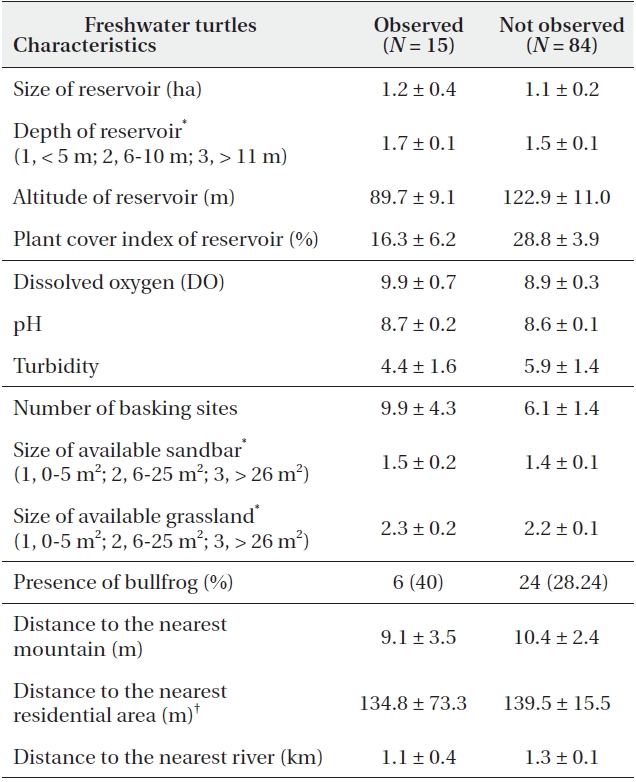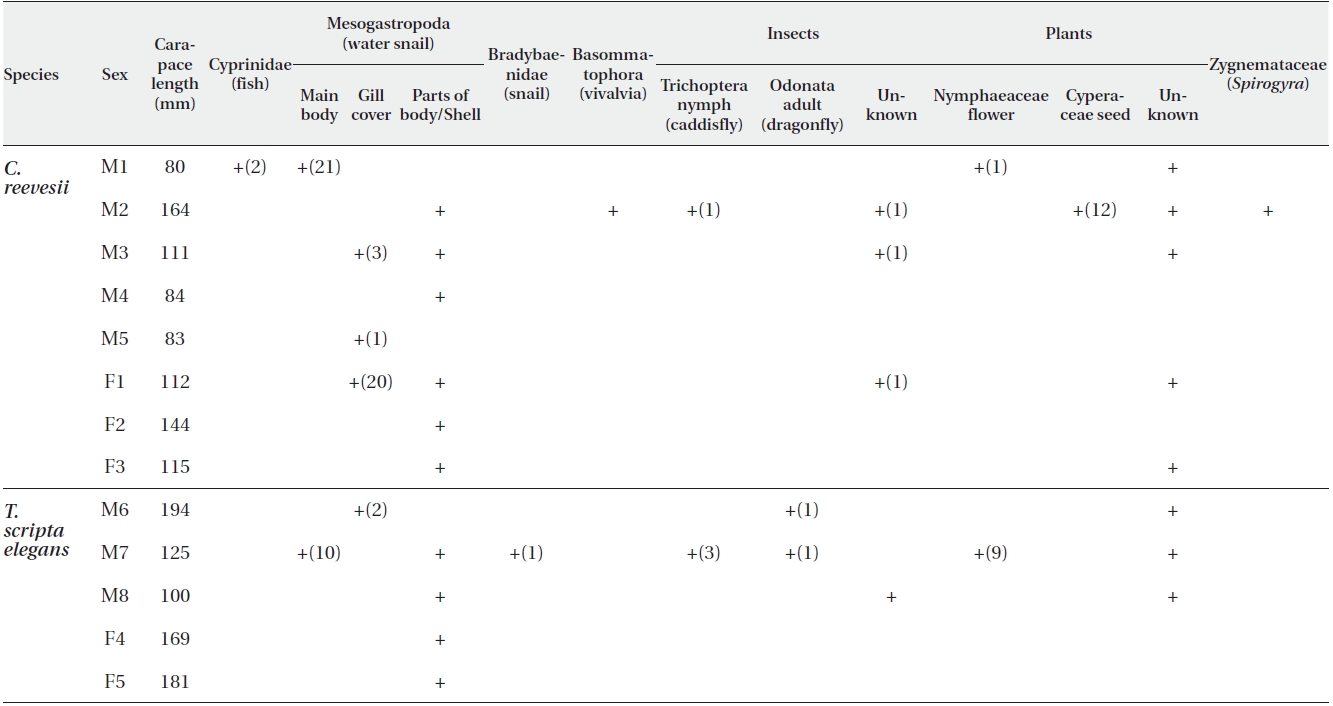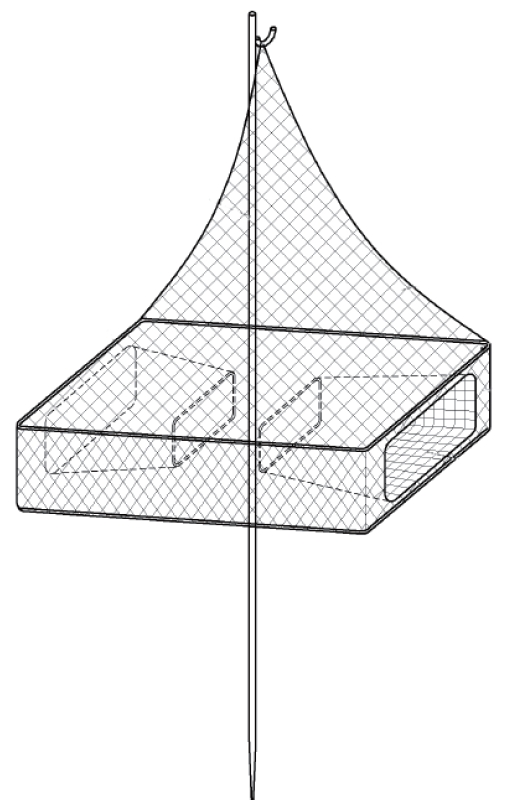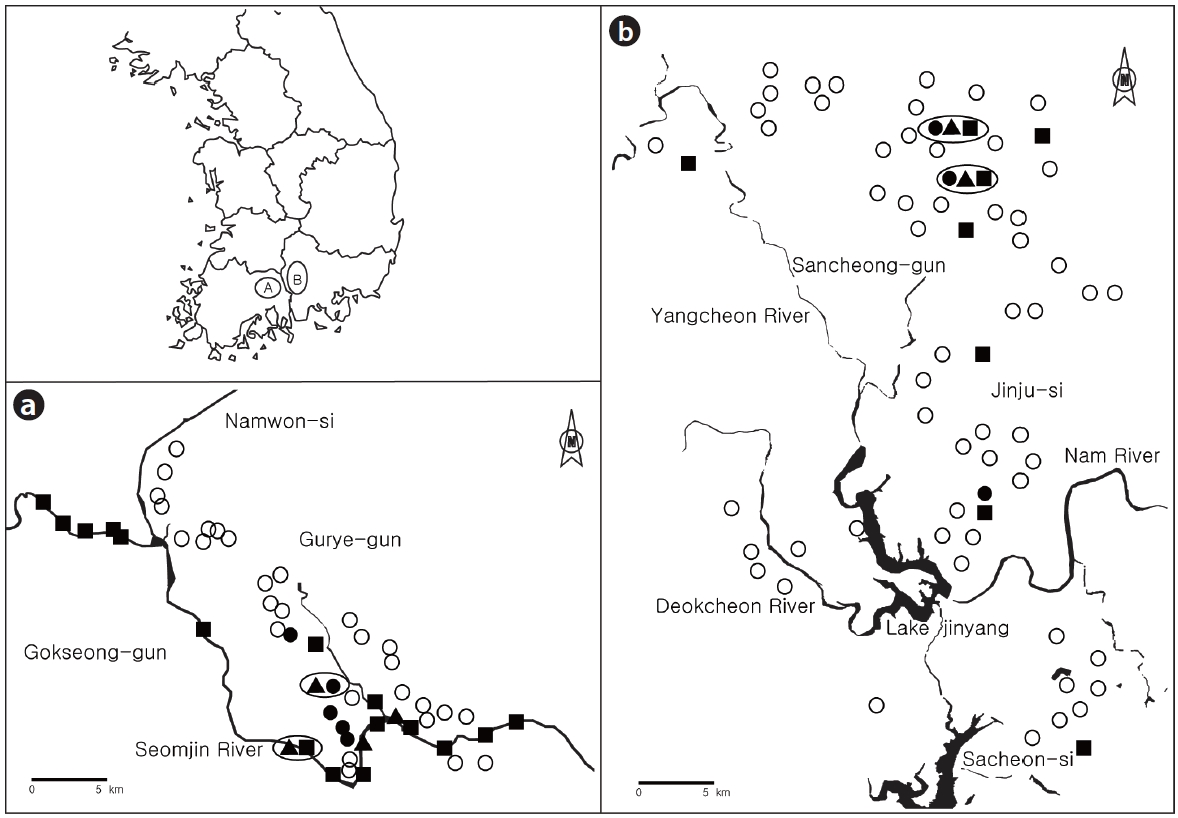



There are approximately 290 different turtle species; among them, 24 species are listed as critically endangered species, 48 as endangered species, and 60 as vulnerable species by the International Union for the Conservation of Nature (IUCN) (Gibbons et al. 2000, Halliday and Adler 2006, IUCN 2010). In order to successfully conserve or restore a turtle species, understanding its habitat characteristics and life history may be a critically important step (Jones 2002). In developed countries, some studies have previously been conducted on the assemblage of turtle species in natural habitats (Vogt and Guzman 1988, Bodie et al. 2000, Segurado and Figueiredo 2007, Haramura et al. 2008), life historical components such as diet, basking site, and nesting site (Bury 1986, Perez-Santigosa et al. 2008, Platt et al. 2009), biotic and abiotic characteristics of natural habitats (Aresco 2009), and captive breeding and developing headstart programs (Grassman et al. 1984, Goode 1994). Based on the results of these studies, projects have been initiated for the conservation and restoration of endangered freshwater turtle species, including European pond turtles (Gariboldi and Zuffi 1994, Rivera and Fernandez 2004, Balazs and Gyorffy 2006, Schweitzer et al. 2008) and western pond turtles (Reese 1996, Hays et al. 1999). On the contrary, only a limited number of studies of freshwater turtles in South Korea have been conducted thus far. Studies have reported the rough distribution of freshwater turtles in South Korea (Song 2007), the distribution and management of the red-eared turtle in Jeju-do (Ministry of Environment of Korea 2003, Oh and Hong 2007), and the morphology and genetic diversity of the Reeve's turtle (Eo 2006).
There are three freshwater species in South Korea: two endemic species and one invasive species (Song 2007). Reeve's turtles (
In order to determine the distribution, habitat characteristics, and diet of freshwater turtles in the surrounding area of the Seomjin River and the Nam River in southern Korea, we conducted field surveys of basking freshwater turtles and analyzed food items in the stomach or feces of caught turtles.
>
Distribution and habitat characteristics of freshwater turtles
We surveyed basking freshwater turtles in multiple locations along the Seomjin River and in ponds and reservoirs distributed along the Seomjin River and Nam River in Jeollabuk-do and Gyeongsangnam-do province in 2009. First, we surveyed basking freshwater turtles in multiple locations along a 48-km stretch of the Seomjin River once between June 17 and June 26 in 2009. To survey basking turtles, we slowly drove a car down the riverside road and stopped frequently in places where we could readily observe good basking sites, such as rocks. We used binoculars (UCF XII, 16 × 25; Pentax, Tokyo, Japan) to observe the turtles. Whenever one or more turtles were detected, the number observed and the locations on the map (1:5,000) were recorded. We did not evaluate the characteristics of riverine habitats in this study.
Additionally, we surveyed basking freshwater turtles in 11 agricultural ponds and 88 reservoirs distributed along the Seomjin River and Nam River, where each body of water was visited twice over four field trips between June 16-27, August 1-5, August 25-28, and September 2-10, 2009. Hereafter, we will consider each pond as a reservoir. To survey the turtles, we initially attempted to observe turtles at a distance using binoculars to minimize disturbances. Whenever necessary, however, we crawled cautiously to the boundary of a reservoir, and observed the turtles basking on logs and rocks, and/or on the water surface. After that, we walked slowly along the reservoir's boundaries while searching for additional turtles.
After surveying the turtles, we evaluated 14 different habitat characteristics (Table 1) in each reservoir. We initially measured the size, altitude, and depth of the reservoirs, the plant cover index of the water surface, the dissolved oxygen (DO) level, the pH, and the water's turbidity. Additionally, we measured the shortest distance between a reservoir and the nearest mountain, residential area, and river or main tributary. The size of a reservoir, measured as the surface area, was estimated using satellite images (2009 smash map data) obtained from a website (http://local.daum.net/map/). The difference in area between field calculations and map estimates was 1.1 ± 0.8 ha SD (

Abiotic and biotic habitat characteristics of the reservoirs where we observed and did not observe the freshwater turtles Chinemys reevesii, Trachemys scripta elegans, or Pelodiscus sinensis
To evaluate the diets of freshwater turtles, we caught the turtles in 6 reservoirs between July 25 and November 5, 2009. We designed a new bait-based capturing trap, and it was successful (Fig. 1). We placed the traps in basking sites and checked the turtles 24 hours after placing the traps. We used pork as bait. When a turtle was captured, we applied a stomach flushing method (Legler 1977) in the field in order to collect food items. To ease the insertion of silicon tubes (4.5 mm outer diameter) into the stomach, we partially anesthetized the neck muscles of the turtles by injecting anesthesia (30 mg/kg body weight Zoletil 50; Vivric, Seoul, Korea). In order to induce the regurgitation of food items, we delivered approximately 100-200 mL tap water into the stomach and individually maintained the regurgitated food items in 95% EtOH until analysis. When the length of the ventral carapace of a turtle was shorter than 7.0 cm, we brought the turtle into a field house and maintained it individually in a plastic box with water at a depth of 5 cm for 12-15 hours in order to collect fecal samples.
Food items in the stomach and feces were investigated under a dissecting microscope (Zeus, China) or microscope (Eclipse 50i; Nikon, Seoul, Korea) in the laboratory. We identified food items in terms of class or order (Table 2), and then classified them further into genera or species. When possible, we counted the number of items. The criteria for an individual in each classification category were as follows: whole body or complete head bone of a fish, main body or gill cover of a water snail, complete head parts of a larval caddisfly or adult dragonfly or any appendages of insects without any whole bodies or heads, a flower possessing a complete calyx and petal, and plant seeds from sedges. In this study, we did not detect the main body and gill cover of water snails together in any turtles. For other food items, we described only the existence or absence of the items in the stomach or feces.
To compare the various habitat characteristics between the sites where we observed and did not observe freshwater turtles, we applied Mann-Whitney's U test because the data did not fulfill the normal distribution assumption (Kolmogorov-Smirnov,
>
Distribution and habitat characteristics of freshwater turtles
From the survey of multiple locations along a 48-km stretch of the Seomjin River, we observed 6 red-eared turtles (2.0 ± 1.0,
We surveyed 34 reservoirs along the Seomjin River (Fig. 2a) and 65 reservoirs along the Nam River (Fig. 2b), and observed a total of 54 turtles in 15 reservoirs. Thirty-three Reeve's turtles (3.7 ± 2.1,
The habitat characteristics between the reservoirs in which we observed and did not observe turtles did not differ for any single turtle species (Mann-Whitney U test,

Food items found in the feces (M2, M3 individuals only) or stomachs (other individuals) of eight specimens of Chinemys reevesii and five Trachemys scripta elegans
We caught a total of 11 Reeve's turtles, 10 red-eared turtles, and 2 mud turtles, and successfully analyzed the dietary materials in the stomachs of 6 Reeve's turtles (3 males and 3 females) and 5 red-eared turtles (2 females and 3 males). We detected no food items in the stomach of mud turtles. We also analyzed the feces of two Reeve's turtles.
We detected water snails in the stomachs or feces of all of the Reeve's turtles and red-eared turtles examined herein (Table 2). Three Reeve's and three red-eared turtles were observed to forage on insects. One Reeve's turtle foraged on fish and one on spirogyra, and two red-eared turtles foraged on adult dragonflies. Five Reeve's turtles and three red-eared turtles foraged on plant materials, including the flowers, seeds, and other parts of plants.
The results of our survey of basking freshwater turtles revealed two important points. First, Reeve's turtles were found inhabiting lentic water bodies, whereas red-eared turtles and mud turtles were detected in both lentic and lotic water bodies. Second, very few Reeve's turtles and red-eared turtles were detected in the reservoirs.
Our results on the distribution of freshwater turtles are largely consistent with previous reports (Kang and Yoon 1975). Reeve's turtles are known to prefer to inhabit lentic waters, such as ponds and reservoirs, although they are also found in the lentic parts of a river (Kang and Yoon 1975, Haramura et al. 2008). By way of contrast, mud turtles tend to prefer water bodies with sand and pebbles at the bottom (Kang and Yoon 1975). During our surveys of the Seomjin River, we observed many adult and juvenile mud turtles and also juvenile red-eared turtles (personal observation), thereby suggesting that they prefer to inhabit lotic water bodies and might be breeding in the river.
In the reservoirs, we observed a very small number of freshwater turtles. In particular, we only observed juvenile Reeve's turtles in one reservoir, and observed no juvenile red-eared or mud turtles in the reservoirs surveyed. It has been estimated that a turtle population requires 50-70 individuals to persist over a long period of time (Reese 1996). Thus, most populations in the reservoirs investigated in this study may be facing extinction (Primack 1993). In particular, Reeve's turtles may be facing extinction in the studied areas, because we observed only juveniles in one reservoir, and their distribution was limited in lentic water bodies. Owing to their long longevity, turtles can be observed for 10-20 years after breeding ceases in a population (Gerlach 2008). When individuals are not continuously recruited into the population, the population will ultimately become extinct. Thus, there is an urgent need to further evaluate the current status of Korean endemic freshwater turtles, and particularly Reeve's turtles.
Among the 14 habitat characteristics, only the distance between a reservoir and the nearest residential areas was significantly negatively correlated with the abundance of freshwater turtles. That is, reservoirs that were located closer to residential areas tended to contain more freshwater turtles. This result indicates that the freshwater turtles observed in this study might be predominantly those that were transported or released by human beings. Generally speaking, the abundance of freshwater turtles at a given site depends on the number of available basking and nesting sites, food availability (Bodie et al. 2000, Segurado and Figueiredo 2007), the primary productivity of habitats, the abundance of predators (Aresco 2009), and the dispersal ability of juvenile and adult turtles (Roe et al. 2009). Even though many of these factors were included in this study, they were not found to be related to the abundance of freshwater turtles. These results may be attributable to our small samples and/or survey methods. We surveyed populations during only a single year, and did not conduct any underwater studies, such as analyses of substrate characteristics and counting turtles in hiding places or foraging underwater. The incomplete nature of our survey methods may be responsible for our small samples: 54 turtles in 15 reservoirs out of 99 reservoirs, which probably resulted in the low statistical power.
Our results demonstrated that the Reeve's turtle and red-eared turtle were omnivorous, and their diets largely overlapped. In particular, all turtles investigated in this study foraged on water snails. Reeve's turtles have been demonstrated to forage preferentially on water snails. In an experimental study, one Reeve's turtle consumed 2,000 water snails within a period of 8 weeks (Yoshie and Yusa 2008). In this study, the turtles also foraged on plants and seeds, larval caddisflies, and fish, thereby suggesting that their primary mode of foraging is underwater. It has been reported in previous studies that the red-eared turtle is omnivorous (Parmenter and Avery 1990, Chen and Lue 1998, Prevot-Julliard et al. 2007). In this study, the turtles were shown to forage on water snails, larval caddisflies, and some plants. We found adult dragonflies in the stomachs of two red-eared turtles, which suggested that they might forage on the water surface like the western pond turtle (Bury 1986). When several turtle species co-inhabit, their window of food items may overlap (Vogt 1981, Vogt and Guzman 1988). Thus, considering that the diets of Reeve's turtles and red-eared turtles overlapped, it might also be surmised that they compete for food.
Red-eared turtles, an invasive species, might negatively affect populations of Reeve's turtles, an endangered species, as well as populations of mud turtles in the field. Red-eared turtles are one of the worst invasive species in the world: they evidence profound reproductive ability in the field (Perez-Santigosa et al. 2008); they compete for basking sites with the endangered European pond turtle (



